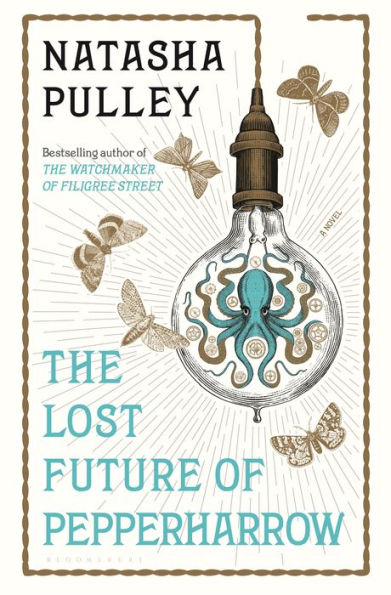In her first two books, Natasha Pulley created a magical, soft-steampunk world inspired by folklore, history, and clairvoyant futurists. Both her debut, The Watchmaker of Filigree Street, and sophomore release, The Bedlam Stacks, share space in the same universe, but are distantly related by small threads. Her newest book, The Lost Future of Pepperharrow, is a direct sequel Filigree Street, taking place five years later.
The story once again follows Nathaniel Steepleton as he makes his way through the world twisted around the machinations of Baron Keita Mori, the Japanese samurai/soothsayer who seems to be pulling the strings of fate in every movement and breath. In this novel, Thaniel and Mori, along with their adopted daughter Six, travel to Japan, where Thaniel takes up a post at the Foreign Affairs office in Tokyo. In the Meiji era, the politics of Tokyo are strung in between Western modernization and traditionalist values. Nearby, strange storms are brewing on Mount Fuji, and people are seeing ghosts.
We’re slowly drawn into affairs of the state; Russians off the coast of Hokkaido, a war-eager Prime Minister, and an embassy that seems unable to aid the British citizenry in Japan. The strange turn of the screw winds deeper and deeper into the woodwork of the story, small bits of sawdust thickening the plot until everything fits together, but only at the very end.
Fans of Pulley’s previous work will appreciate her style; a slow-to-ignite layering of many conspiracies, the barest scientific justification in science fiction, and the slight twist of historical fact and myths. Small complications and adversaries of circumstance eventually culminate in a race against time, all operating along the railroad-line justification of Mori’s making. Chance seems to play a large part of many plot points, all explained by the basic premise of Mori’s nearly omniscient power. The magical way that science is woven into understanding the world is unique, if oversimplified. Electric discharge activates intentional shades of past movement, which appear as ghosts in smoky rooms and foggy streets. It doesn’t really make sense, but it’s not so ridiculous that you dismiss it entirely. Intention is always a powerful thing.
Buy the Book


The Lost Future of Pepperharrow
While Pulley’s previous novels were relatively condensed, which allowed for an expansive building of characterization and plot in the beginning that tied up nicely just as all the breadcrumbs started to pile up. This novel, however, is not constrained by the length of the previous books, and the slow folding and unfolding of the plot takes over half the book to fully coalesce into action and movement. It moves fast in parts, speeding through an escape from prison in just a few paragraphs, but slow in others, keeping characters in said prison for long swaths of time as they clean rooms and make tea without much narrative payoff.
When things start to finally become understood, and all dead ends are explored, there is a sense of throwing darts in dark room, where Mori is the only one who knows where the board is. The way that the two point of view characters go through their narrative is like the arms of an octopus. They slowly outstretched, feeling a plot, story, or understanding, and then at a dead end, quickly retreat to a familiar place, relying on Mori’s power to take care of the loose ends.
The relationships of the first novel are also present, and it feels necessary to have read Filigree Street before diving into Pepperharrow. The intricacies and details of each relationship is hard to replicate in summary, and the result is that the book reads as if Pulley assumes you already have a working knowledge of the people involved, and in fact, some essential points of the lot rely on this understanding..
For example, how Thaniel has a daughter who is not his biological child is often alluded to, but never explained. We also have the former Mrs. Steepleton, (now, once again Dr. Carrow) appear as a character of import, without really explaining what happened. Pulley, who seems unable to let characters go, ties characters present in The Bedlam Stacks into the final chapter with a passing comment that would be nearly indecipherable to anyone unfamiliar with her second novel.
But, here is where the struggle of the book becomes crystallized. Since we know at the beginning of the book that Mori knows the future, or at the very least, understands the vast possibilities of the future, we automatically assume that he has intended for everything to happen the way that it occurs. In the first book discovering Mori’s ability was a major way for the reader to understand and make sense of the narrative. But now that the reveal has occurred, we’re left knowing that for Mori, and for the events surrounding him, there are almost no surprises. It is because of this constant in the story that when Thaniel (who was in a romantic relationship with Mori at the end of Filigree Street) is hurt and upset after learning that Mori has a secret wife, we can only assume that Mori knew this would happen and did nothing to assuage Thaniel’s emotions.
Besides Mori being something of a mind reader, he’s also an adult with a working knowledge of how actions affect others. However, throughout the book his ignorance or unwillingness to treat anyone as anything other than objects in a long, twisted game of fate makes him unlikable at best and unforgivable at worst. I was barely fifty pages into the novel before I found myself wondering “Is Mori the villain of this story?” Reader, it is not a stretch to say that he is.
Women in particular are vulnerable to Mori’s scheming, as most end up dead or abducted before the end of the novel. His antiquated views on women seem less charming when he states that he would rather leave England forever than be present when women get the right to vote. At the very least, Mori is not a kind, nor an easily forgiven character, considering his ability to tell the future. It’s because of this that his actions and his callousness becomes harder and harder to justify, especially when we are attached to individual characters, and not considerations of the state or the world, as Mori is.
The problem with clairvoyance as a plot device is that the reader is always playing catch up. Admittedly, in every novel the reader is always a few steps behind the narrative, but in books where the ability to predict the future is built into the conceit itself, we are acutely aware of the difference, and the distance, in between author and reader. The shadow that an omniscient and omnipresent character casts is long and impossible to ignore. As soon as we think something is happening, the author twists, avoiding our grasp, and that something rarely materializes, making the foreshadowing feel impossible. What parts of Mori’s plan are actually in effect? What good is free will if Mori can manipulate you into doing exactly what he wants, without actually explaining himself?
The implicit contrivance of a novel is made even more clear as we are reminded again and again that we don’t know what is going on, and we cannot predict the ending at all. It follows a similar structure to Filigree Street, and fans will recognize the dead-end-ness of the narrative that Pulley ties together.
One of the reasons that Filigree Street was so good was the authenticity and grime the author brought to Reconstruction-era London. The same feeling of fantastic reality has not been ported into Meiji-era Tokyo, despite the author’s best efforts to create a nuanced world. Instead, since all we read about is a city electrified and people with menial jobs dismissed as “superstitious,” Tokyo is automatically othered within the text. This is only amplified by the fact that the main character is English, and the second point of view character is ostracized because of her English father. Otherness is never far behind any perspective, and most of the othering is tied to Japan and Japanese heritage. This might have been combated within the plot, except the deeply political nature of the plot forces an unfortunate exoticism.
With a desire to demystify Japan and remove caricatures from her writing, Pulley has instead created a strangely mishmashed world where men refer to Thaniel as Mori’s “geisha” and Thaniel asks a woman if she’s “half and half.” For a modern author who does make an attempt to talk about the dangers of imperialism and orientalism, she seems to mismanage her ability to make keen observations of the world with her desire to create a clear, yet unpolished view of Japan.
The Lost Future of Pepperharrow is, ultimately, a book for Pulley’s fans. It will be a hard sell for new readers, as it will take too long to pay off and requires a strong understanding of the characters from the first page. Faithful readers will recognize her slow-burn style, and the deft weaving of worlds, futures, pasts, and ideas into a larger tapestry that is really only revealed in the last few chapters of the novel. Her prose remains stunning, if sometimes baffling (there is a line, for example, where Mori motions “to Thaniel’s lungs with his eyelashes,”) creating a world that seems fully embedded in its premise. It’s obvious that Pulley’s meticulous planning has come to bear in this novel, but whether or not is enjoyable is a matter of personal taste.
The Lost Future of Pepperharrow is available from Bloomsbury.
Read an excerpt here.
Linda H. Codega is an avid reader, writer, and fan. They specialize in media critique and fandom and they are also a short story author and game designer. Inspired by magical realism, comic books, the silver screen, and social activism, their writing reflects an innate curiosity and a deep caring and investment in media, fandom, and the intersection of social justice and pop culture. Find them on twitter @_linfinn.










